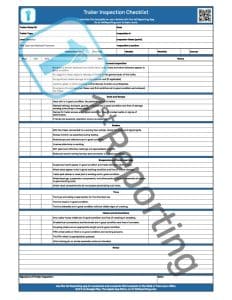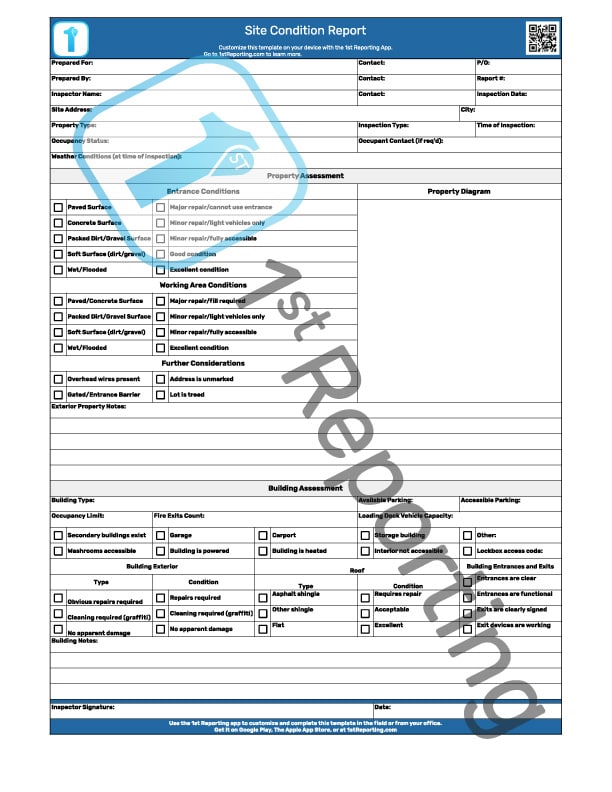Using a trailer inspection checklist is crucial to ensuring safety on the roads. Why? Because it ensures that your drivers don’t forget to check any safety-essential items. Similarly, it provides a means of documenting the inspection’s findings.
A trailer inspection checklist allows equipment and vehicle drivers to document trailer inspections. Our list is downloadable and works well for low-bed, high-bed, and even covered or enclosed trailers.
In this guide, we’ll review the trailer inspection checklist template and provide you with some insights and instructions for use and best practices. Feel free to bookmark this guide to aid your team with training vehicle operators – it will save you time and money. Let’s get into it.
Included in the Trailer Inspection Checklist
There are eight sections to the Trailer Inspection Checklist. The included sections are outlined below.
Administrative Information
The administrative section of the Trailer Inspection Checklist intends to simplify the organization and data retrieval process. The section includes vital information for keeping your reports sorted, organized, and in order. Similarly, the data included allows for a quick glimpse of the equipment specifications and parameters, making analyzing inspection results even more straightforward.
General Inspection
The General Inspection section encompasses general trailer condition, fasteners, latches/gates, and safety equipment. It is essential to inspect these components as they are vital for safe operation and passenger comfort. Items like visual checks, tire condition, trailer brakes, lighting systems, and safety equipment should be examined thoroughly and recorded with detailed information.
Deck and Ramps
The Decks and Ramps section is, like the other sections, self-explanatory. The points include testing of powered ramp equipment, and also each section and question includes a notes area on the right where the inspector can note further observations.
Brakes
One of the most important parts of any moving vehicle is, of course, the brakes. For convenience and due to further safety-related importance, we’ve included further safety items required. These further items include license plate lamps and reflective markings – significantly reducing the potential for careless accidents.
Suspension and Undercarriage
The suspension and undercarriage of some types of low-deck trailers are difficult to inspect. They are equally essential to inspect and should not fall into ambiguity. We’ve also included trailer jack components in the undercarriage section for ease of inspection. This inclusion allows the inspector to focus on the entire underside of the trailer at once, keeping the inspection more focused and efficient.
Tires
Tires are a vital component, literally maintaining contact with the ground. Without good tires, brakes are almost irrelevant. Not to mention, a tire blowout while under load is not a situation you want to face. For this reason, we’ve taken extra time to outline the essential tire-related items in our checklist.
Hoses and Connections
The hoses and connections section of the Trailer Inspection Checklist also includes the hitch or fifth wheel and emergency chains. Again we’ve tried to encompass all your trailer needs within each section. However, we’ve given ample space to include other components.
Notes and Sign-Off
To legitimize the inspection, the inspector must include their signature and the date at the end of the inspection checklist. As mentioned, we’ve included a notes section for any further components for specialized trailers. However, we might have the best thing you’ve yet to see if you’re looking for a customized solution. Take a look in the Tips and Best Practices section to follow.
How To Use The Trailer Inspection Checklist
If you’re like most business owners, you’re always looking for ways to save money and streamline your operations. One way to do that is by performing regular trailer inspections using a commercial trailer inspection checklist. This section will provide a guide on how to use the checklist effectively.
1. Prepare the trailer: Before you begin your inspection, ensure all trailer components are adequately secured. It includes checking lug nuts, tire pressure, and air brakes.
2. Have necessary tools on hand: To complete an inspection effectively, you will need specific tools like a flashlight, tape measure, grease gun, and felt-tip pen. Make sure these items are ready before starting the inspection process.
3. Review every trailer component: The checklist is designed to help you identify any potential issues with each trailer component. Take your time to review and inspect every part thoroughly. Pay special attention to tires, suspension systems, and brake lines for abnormalities or wear and tear.
4. Make notes of any issues: As you go through the inspection process, note any issues that need to be addressed or fixed. Please keep track of these items so they can be handled promptly.
5. Follow up after the inspection is complete: Follow up by fixing any problems and documenting your results once your assessment is finished. It will keep your trailer in top condition and ensure it continues to operate safely and efficiently.
What To Do If You Find A Problem During The Inspection Process
If you find a problem during the inspection process, it is essential to address it immediately. Depending on the issue, you may be able to make repairs yourself, or you may need to contact a professional for assistance. Some common issues that may arise might include the following:
• Tire problems – flat tires, improperly inflated tires, worn treads
• Suspension problems – broken springs, faulty shocks, loose nuts and bolts
• Brake line issues
• Excessive rust or corrosion
• Lights/reflectors not functioning properly
Contact a qualified mechanic or trailer repair shop for more severe issues, such as brake lines and suspension components, requiring immediate repair or replacement. The best way to protect yourself and your cargo is to ensure that no matter the issue you find, you report it to your supervisor immediately.
By following this guide, you can use the trailer inspection checklist effectively and save time and money by identifying potential problems early on. Additionally, adhering to regular maintenance schedules will help increase the longevity of your trailer’s life span.
Tips and Best Practices for Trailer Inspection Management

The Large Truck Crash Causation Study conducted by the Federal Motor Carrier Safety Administration and the National Highway Traffic Safety Administration found that in their sample group, 77 percent of the large trucks involved in crashes were towing a single trailer. As much as 5% were carrying hazardous materials.
The most significant amount of crashes involving commercial trucks include trailers. We as a society must improve our trailer safety – and that starts with good inspections.
Here’s a group of tips and best practices to help you manage your organization and team’s vehicle and trailer inspection process.
• Educate Personnel On The Importance Of Trailer Inspections.
The damage that a runaway trailer can cause is enough to kill someone. You can well imagine the severe consequences of such an event. Remember, negligence is not a defense; a robust preventive measure is a strong defense that could save someone’s life.
• Utilize A Procedural Checklist For Each Inspection.
Procedural checklists are handy when complex inspections or incidents arise or, in the case of an injury, easy to forget critical actions. When inspecting a low-bed trailer, it’s easy to miss undercarriage points of concern. Similarly, high-bed trailers also pose different inspection items than you would anticipate in a covered or enclosed trailer. For these reasons, it’s best to use a procedural checklist to ensure concise and accurate reporting.
• Document The Results From Inspections And Repairs.
Moreover, don’t be afraid to take a step back and analyze your inspection reports. This endeavor might be challenging with paper reports, so we recommend utilizing an inspection reporting solution like 1st Reporting.
• Regularly Perform Preventative Maintenance Checks On Trailers
Even if a trailer sits dormant, you must ensure regular inspections occur. Brakes are notorious for seizing up in time without use.
• Stay Up To Date With Changing State Or Province And Federal Regulations
You must consult a local authority for specific regional requirements for your trailer’s certification. Most regions require annual safety inspections, but in order to ensure compliance, your local authority will know for sure.
• Provide Your Team With A Robust Solution
Documentation of safety inspections is critical. However, using paper checklists and reports poses several concerns. First, you’ve got printing and distribution concerns. If you’re operating a multi-location organization, it can be quite a challenge.
However, have you considered integrating a digital solution instead? You’ll save more than just printing costs; you’ll save time and prevent unnecessary hurdles.
Here are a few ways that a robust inspection app can supplant the need for paper checklists.
- Changes to a checklist are instant on a digital platform—no need to redistribute amended newly printed checklists.
- Automated processes that only a digital solution like 1st Reporting provide efficiency to mundane processes. Never will a team member forget to contact their supervisor again. With customizable notifications, you can set an automated notification to contact the right person when the worker submits the report.
- Mobile and customizable solutions using our digital platform mean that no team member can ever say they forgot their form at the office. You control the team to access and can use the powerful custom form builder to create the perfect checklist or form for your needs.
That’s just a few of the robust solutions. 1st also integrates with Microsoft Teams® and has a powerful management dashboard so you can easily create custom reports and use the map view to view all your team’s submitted reports.
By following these tips, you will be better equipped to ensure your team’s safety and streamline operations in an ever-changing commercial trucking industry. Keeping these best practices in mind when managing your organization’s vehicle and trailer inspection process can help protect everyone involved on the road.





